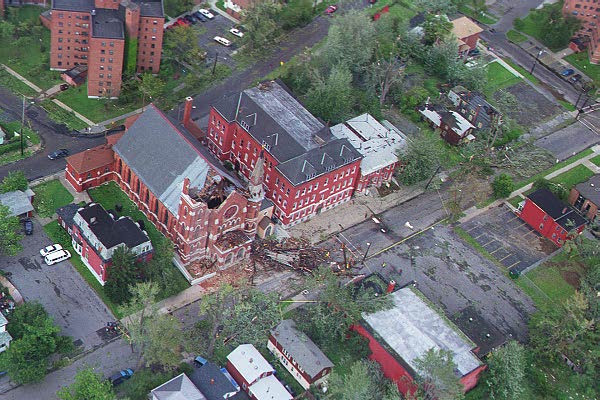
Shortly after 1 am on the morning of Labor Day 1998, a line of fierce thunderstorms moved into the area, striking Central New York from the west with wind gusts of up to 115mph. The storm devastated the community, damaging hundreds of buildings and tens of thousands of trees. More than 200,000 people lost power, which was not restored to some until the following week. New York State declared the community a disaster area and federal aid was sought.
Hundreds of work crews, including utility squads and National Guard Troops, worked around clock to overcome mounting problems. Traffic lights were out, the State Fair was closed, bus service was cancelled, and many schools were closed for more than a week. Niagara Mohawk incurred millions of dollars in costs to restore power. Scenic neighborhoods, parks, golf courses, arboretums, Burnet Park Zoo, and historic Oakwood cemetery suffered severe tree losses. The storm caused tens of millions of dollars in damage to the area. However, the city was resilient. By Friday most damaged businesses had reopened at least on a limited basis.
The following is a description of the storm via the Storm Prediction Center – NOAA/National Weather Service: “Just before midnight on Sunday evening September 6, 1998, a derecho formed over western New York and moved rapidly east during the early morning of Labor Day (September 7th), reaching the New England coast by 6 a.m. EDT. Wind damage occurred in much of the area outlined in green in Figure 1. Some of the worst storm damage occurred in a band across western and central New York, from Rochester to Syracuse and near Utica. The derecho storm system reached the Syracuse area (“S” in Figure 1) just after 1 a.m. EDT. Three people were killed and 10 were injured in Syracuse, mostly at the New York State Fairgrounds. Measured wind gusts of 89 mph at the Rochester Airport and 77 mph at the Syracuse airport were recorded. Winds were estimated to have reached 115 mph in the most seriously-damaged areas. Along the derecho path, tens of thousands of trees were blown down and over 1000 homes and businesses were damaged. Damage was estimated at about 130 million dollars. Hundreds of thousands of homes and businesses lost power, with some remaining without power for a week.
A radar reflectivity image and animated radar loops for the Syracuse Labor Day Derecho were provided by National Weather Service (NWS) meteorologist Jeff Waldstreicher. The thunderstorm system that produced the derecho began as a supercell. The supercell subsequently evolved into a bow echo as shown this animation of reflectivity from the Buffalo, New York NWS radar. The bow echo storm system then moved across central New York and the Syracuse area (SYR), growing in scale as shown in this loop from the Binghamton, New York NWS radar.
Damage photos from the event may be found on the Buffalo and Binghamton NWS web sites. Additional information on the Syracuse Derecho is available on the Binghamton site.”

